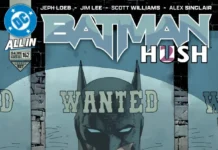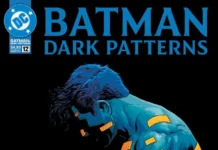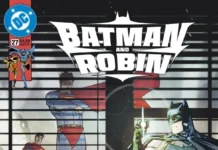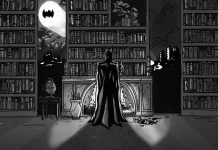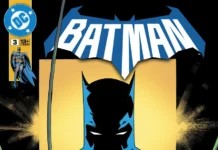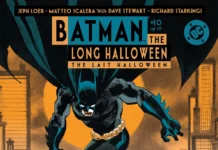SYNOPSIS: Monster men continue to terrorize Gotham City, but with the body count rising, the GCPD is no closer to solving the mystery behind these seemingly undead assailants, and the Bat-Man and Gordon are the only ones willing to brave the criminal underworld to crack the case. It’s after a near-death brawl saving the mayor from the monster men that the Bat-Man must face a stark reality…are his fists and willpower enough to save Gotham?
 Jurgens and Company waste no time in immersing the reader once again in the world of 1939, starting with a cover that seems inspired by the classic Detective Comics #31, then launching into publications brandishing fictional headlines to help you understand the setting. I loved it last time and continue to appreciate it with this issue.
Jurgens and Company waste no time in immersing the reader once again in the world of 1939, starting with a cover that seems inspired by the classic Detective Comics #31, then launching into publications brandishing fictional headlines to help you understand the setting. I loved it last time and continue to appreciate it with this issue.
Then things really get cooking (literally) as we pick up right where the story left off. If Batman falling to Earth from orbit isn’t your cup of tea, well, the Batman here is very human. Sure, they may be pushing the boundaries of what a man can endure. Still, artist Mike Perkins depicts a Dark Knight at his most vulnerable, literally smoking as he makes his getaway in a splash page that had echoes of Year One to me, causing me to recollect when Batman was injured under the stairwell.
One thing that stands out to me is how lonely this Batman seems. With no Alfred to come to his rescue and drive him to safety, he has to steal Gordon’s car and then nurse himself back to health. It’s hard to think of Alfred as being dead in the main books when so many tales and Black Label stories keep him alive, but his absence is keenly felt here. It is accurate for the period, but it shows how indispensable the character is.
Not that The Bat-Man is alone, though, He does have the aforementioned aid of Commissioner Gordon, and of course, Rabbi Cohen. I don’t know what to make of the rabbi. Is he as benevolent as he seems, or is something sinister lurking beneath the surface? Jurgens has Bruce place a lot of faith in this new character, delivering some meaningful character moments. Of course, these moments make me wonder how this relationship will end, but their interactions enable Jurgens to bring up another theme — why does Batman not use guns?
A lot has been said about Batman’s historical use of firearms early in his inception and his staunch position against them in the decades since. Narratively, Jurgens seems to be having his cake and eating it, too, delivering a Batman who explains his very personal rationale for not bearing arms, yet placing him in a position where he may be forced to do so, being encouraged by Gordon and Rabbi Cohen, as well. Of course, the story is setting us up to see The Batman gunning down the reanimated corpses of these “Monster Men” and I have to applaud how Jurgens is reinterpreting this classic tale under the lens of Black Label. It’s almost Morrisonian-working these two seemingly contradictory elements of Batman’s history into a cohesive narrative, not to mention another way of tackling a topic also examined in Batman: Year Two.
I’m also enjoying his depiction of Julie Madison. She is forthright, honest, intelligent, and highly observant, all traits I can see Bruce Wayne appreciating and falling in love with. She challenges him and intrigues him, in addition to having a progressive sense of honor for the time period. She only has one scene yet again, but it’s a memorable one, bringing vitality to a character that is often a footnote, dare I say, a trivia question, in the Dark Knight’s history.
The action is top-notch under Mike Perkins’ pencils. There is a brutality and sense of pain in those scenes, including a vulnerability felt by Batman. He has to struggle, adding to the thrill of the fights, particularly when he triumphs. The demonic horns on his cowl seem more extreme this time as well, something I enjoyed seeing depicted.
Mike Spicer’s colors also aid the storytelling, bringing a pop to a very otherwise dark-looking book. There is a lot of great contrast throughout and he really makes the characters stand out. Furthermore, I appreciate the different hues he gives the Gotham night sky. Oftentimes, it feels like one color becomes the default for a series, but the issue trades off greens, purples, and blues scene by scene, providing a sense of variety.
Jurgens’ writing is extremely strong, letting characters stretch their legs and highlighting the dangers of Gotham City in a very tense world already. The threat of global war isn’t quite as strong this time, but its presence is still felt. Gordon, in particular, has endured the horrors of war, and that has helped shape the man he is.
Every element combines to add a sense of verisimilitude to a story that has reanimated criminals assassinating political figures. It’s hard to believe that everything concludes next issue as I want to spend more time in this Gotham. There is so much to explore in this rich world and it feels like it’s ending just as it’s getting started. So, take a trip back to 1939, a time that wasn’t so simple after all, and thrill to the dawning exploits of The Bat-Man! You won’t regret it! – Javier E. Trujillo
GRADE: A+




